 |
 |
 |
| |
Atazanavir/Ritonavir vs Lopinavir/Ritonavir in Antiretroviral-Naïve HIV-1-Infected Patients: CASTLE 96 Week Efficacy and Safety
|
| |
| |
Reported by Jules Levin
ICAAC/IDSA, Oct 27, 2008 Wash DC
J-M. Molina,1 J. Andrade-Villanueva,2 J. Echevarria,3 P. Chetchotisakd,4 J. Corral,5 N. David,6 M. Mancini,7 R. Yang,7 D. McGrath,7 J. Absalon7 1H˘pital Saint-Louis, Paris, France; 2Hospital Civil De Guadalajara, Guadalajara, Mexico; 3Hospital Nacional Cayetano Heredia, Peru; 4Khonkaen University, Khonkaen, Thailand; 5Hospital Interzonal Gral. De Agudos Oscar Alende, Buenos Aires, Argentina; 6Brooklyn Medical Centre, Western Cape, South Africa; 7Bristol Myers Squibb, Wallingford, CT, USA
AUTHOR CONCLUSIONS
Noninferiority of once-daily ATV/RTV compared with twice-daily LPV/RTV was
confirmed at Week 96
In the ITT analysis, ATV/RTV had higher response rates than LPV/RTV
- This difference, not observed in the on-treatment analysis, was driven by similar virologic efficacy and a higher rate of discontinuations among patients receiving LPV/RTV
High response rates with ATV/RTV were demonstrated irrespective of disease severity at baseline (high viral load, low CD4 count)
Virologic failure rates were low and the emergence of resistance was infrequent with both regimens
ATV/RTV had a better lipid profile and more favorable gastrointestinal tolerability
than LPV/RTV
- Mean changes from baseline in fasting TC, non-HDL-C, and TG at Week 96 were significantly higher in patients receiving LPV/RTV than those receiving ATV/RTV
- Fewer gastrointestinal events were experienced by patients receiving ATV/RTV than those receiving LPV/RTV
No new or unexpected safety events were identified
Once-daily ATV/RTV plus TDF/FTC demonstrated durable antiviral efficacy and safety. This regimen is an appropriate therapeutic option for antiretroviral-naïve HIV-1-infected patients.
ABSTRACT
Background
ATV/RTV has similar efficacy to LPV/RTV with more favorable lipid and GI profiles in treatment-naïve HIV-infected patients after 48 weeks of therapy. Efficacy and safety through Week (Wk) 96 are presented.
Methods
Randomized, open-label, prospective study of once-daily ATV/RTV vs twice-daily LPV/RTV, both with fixed-dose tenofovir/emtricitabine in 883 treatment-naïve patients. Analyses at Wk 96: % with HIV RNA < 50 copies/mL (c/mL), emergence of resistance, adverse events (AEs), _ CD4 cell count and fasting lipids.
Results
Overall 19% of subjects discontinued before Wk 96 (16% ATV/RTV, 21% LPV/RTV); 39 LPV/RTV subjects (9%) switched to tablet formulation after Wk 48.
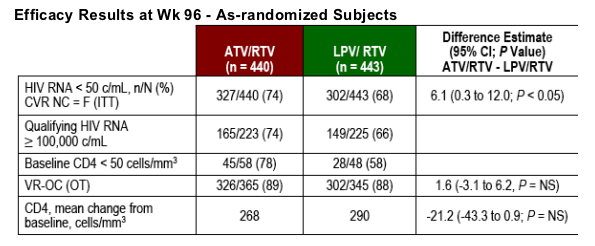
Virologic failure was low in both arms (30/440 ATV/RTV, 29/443 LPV/RTV, 7%).
Grades 2-4 related hyperbilirubinemia was greater on ATV/RTV (7% vs < 1%);
grades 2-4 related diarrhea (12% vs 2%) and nausea (8% vs 4%) were greater on LPV/RTV.
Mean percent _ in fasting TGs and TC from baseline were significantly lower on
ATV/RTV vs LPV/RTV (13% vs 50% and 13% vs 25%, respectively; P < 0.0001).
Conclusions
Noninferiority of ATV/RTV vs LPV/RTV was confirmed at Wk 96. In the ITT analysis, ATV/RTV had higher response rates. This difference in response was driven by discontinuations among subjects on LPV/RTV. ATV/RTV continues to demonstrate a better lipid profile and fewer GI AEs vs LPV/RTV.
STUDY DESIGN
International, multicenter, open-label, randomized, 96-week study to determine the comparative clinical efficacy and safety of ATV/RTV and LPV/RTV in treatment-naïve HIV-1-infected patients (Figure 1).
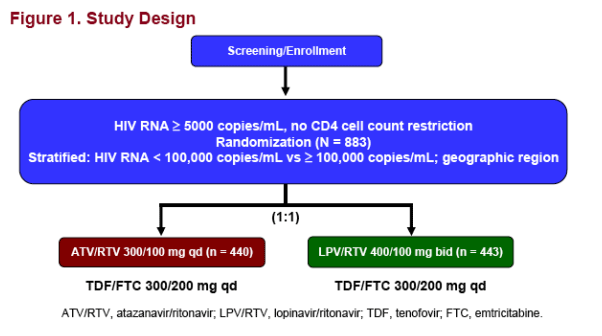
OBJECTIVES
Primary Objective
Demonstrate noninferiority of ATV/RTV once daily versus LPV/RTV twice daily based on primary end point
- Δ -10%, ATV/RTV - LPV/RTV
Primary End Point
Proportion of subjects with HIV RNA < 50 copies/mL at Week 48
- Principal analysis: confirmed virologic response, noncompleter = failure (CVR, NC = F) - intent-to-treat (ITT)
- Supportive analyses:
· Time to loss of virologic response (TLOVR - ITT)
· Virologic response-observed cases (VR-OC) - on-treatment (OT)
Secondary End Points
-Proportion of subjects with HIV RNA < 50 copies/mL at Week 96
-Changes from baseline in absolute CD4 count through Week 96
-Resistance profiles; virologic failures; genotypic and phenotypic testing
-Adverse events (AEs)
-Changes in fasting lipids; fasting lipid National Cholesterol Education Program
(NCEP) shift, and ratios
RESULTS
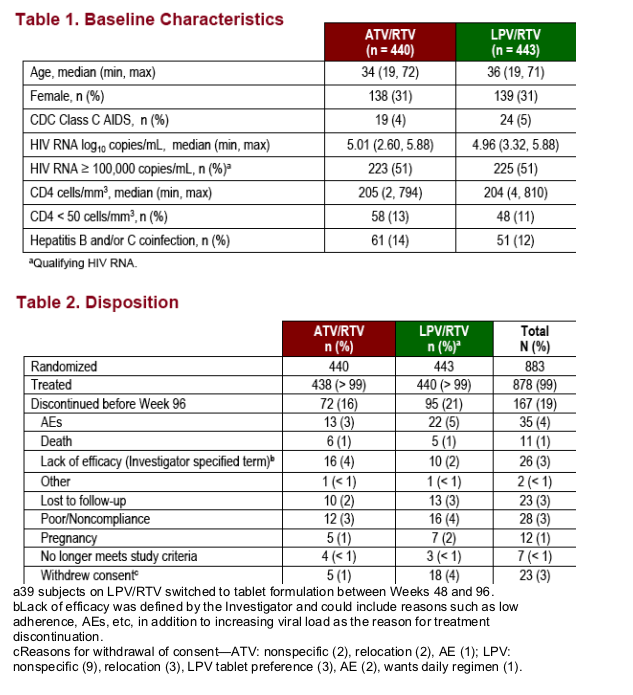
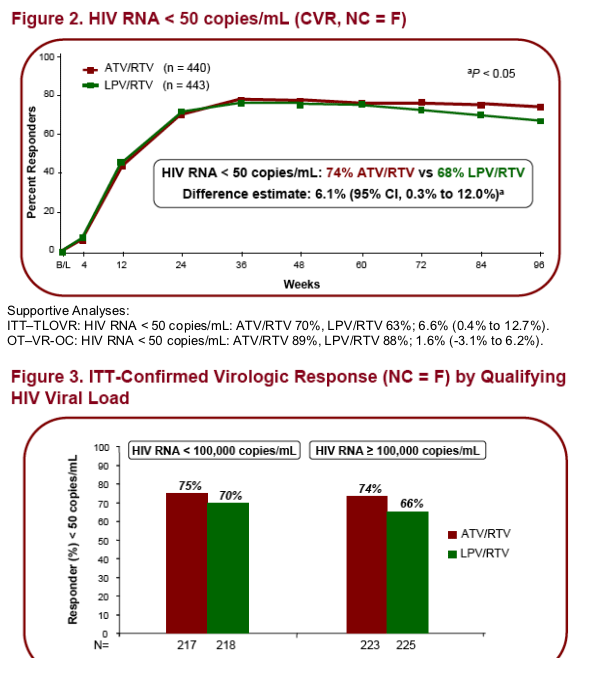
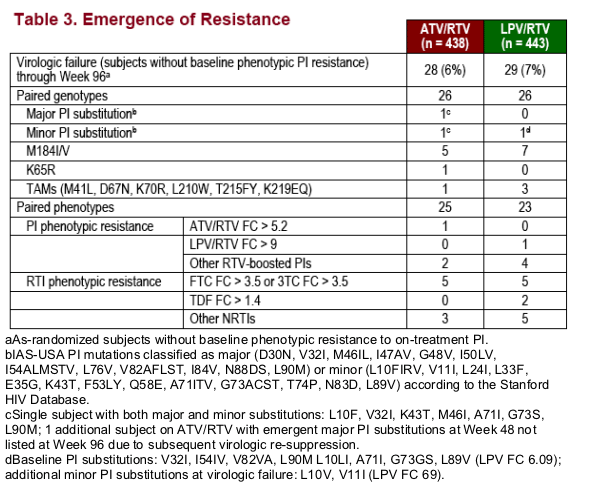
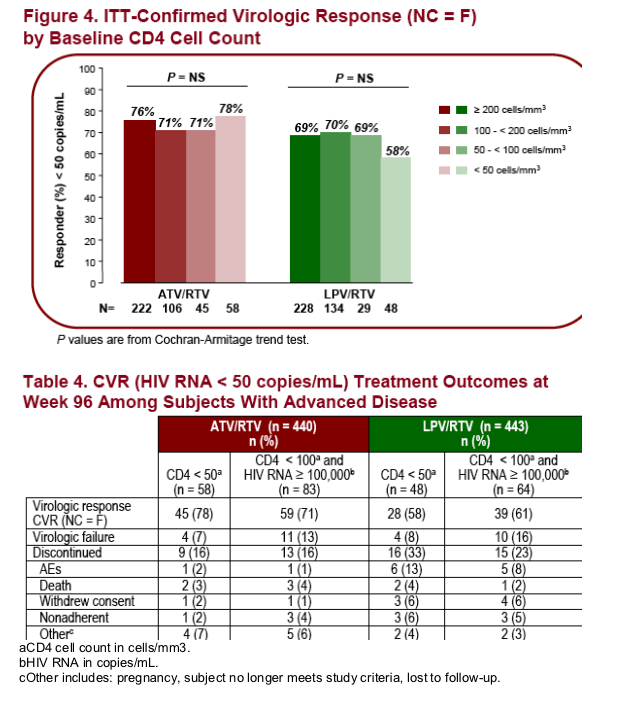
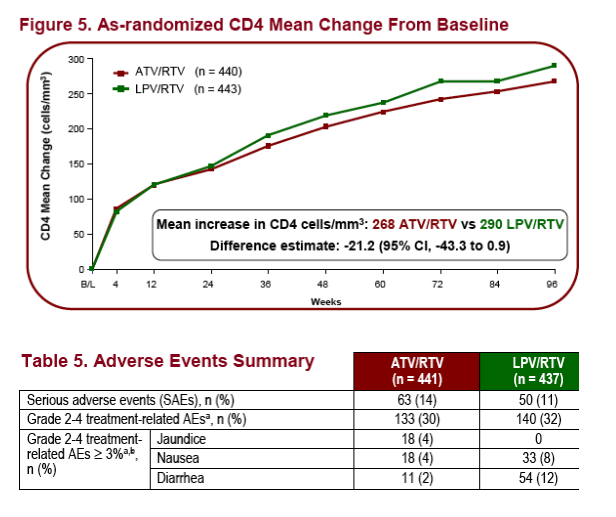
· 39 (9%) subjects on ATV/RTV versus 96 (22%) subjects on LPV/RTV initiated antidiarrheal medications
· 7 subjects discontinued due to diarrhea (all on LPV/RTV)
- 2 between Weeks 48 and 96
· 3 discontinuations on ATV/RTV due to jaundice/hyperbilirubinemia
- None between Weeks 48 and 96
· Renal all-grade AEs: 4% in both arms
- 1 discontinuation due to renal AE in each arm
aThrough 96 weeks.
bExcluding laboratory abnormalities reported as AEs.
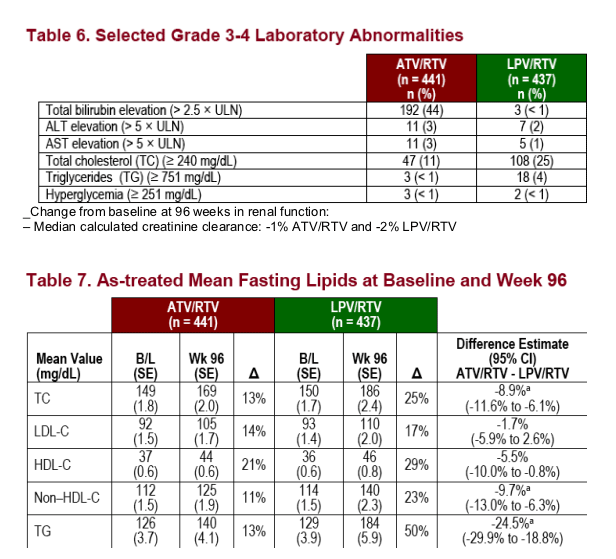
Values presented are observed values. Analyses using last observation carried forward (LOCF) are consistent with the above results. Values were excluded after the start of serum lipid reduction therapy.
aP < 0.0001.
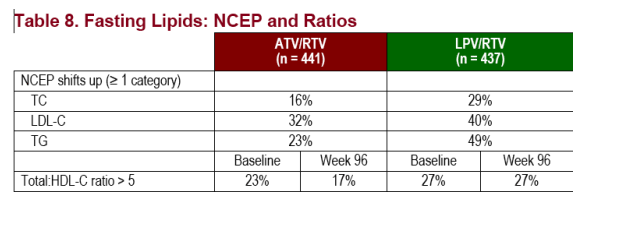
2% of subjects on ATV/RTV versus 9% of subjects on LPV/RTV initiated lipid-lowering drugs on study.
|
| |
|
 |
 |
|
|